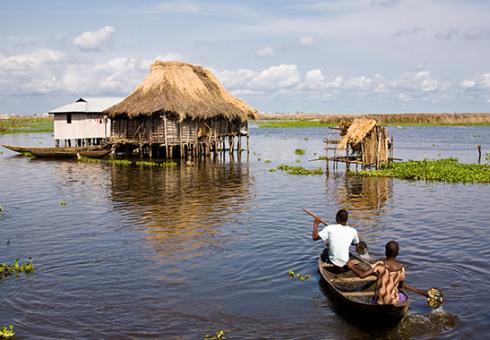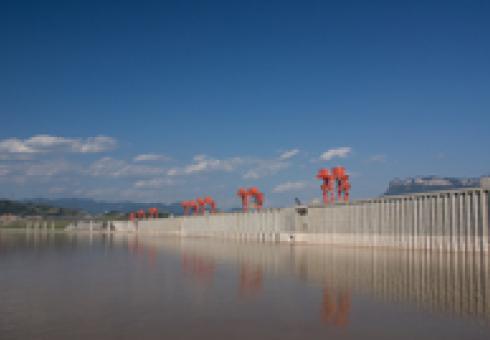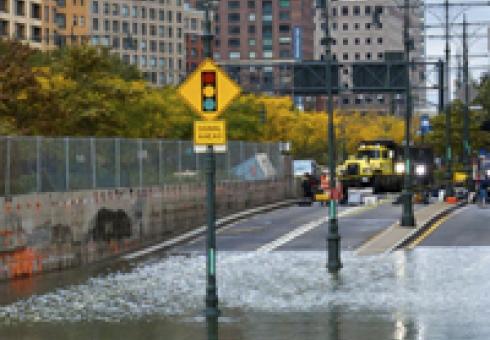C. Adam Schlosser assesses long-term risks to regional water and energy systems
News and Outreach: C. Adam Schlosser
A new study points to the risk that China and India will be facing severe water shortages by 2050 due to a perfect storm of economic growth, climate change, and fast growing populations. Joint Program Deputy Director Adam Schlosser comments on the future of water stress in Asia.
Study finds high risk of severe water stress in Asia by 2050
Includes commentary by John Reilly and climate change calculator based on methodology co-developed by Adam Schlosser
Alli Gold Roberts
MIT Joint Program on the Science and Policy of Global Change
Population growth and increasing social pressures on global water resources have required communities around the globe to focus on the future of water availability. Global climate change is expected to further exacerbate the demands on water-stressed regions. In an effort to assess future water demands and the impacts of climate change, MIT researchers have used a new modeling tool to calculate the ability of global water resources to meet water needs through 2050.
The researchers expect 5 billion (52 percent) of the world’s projected 9.7 billion people to live in water-stressed areas by 2050. They also expect about 1 billion more people to be living in areas where water demand exceeds surface-water supply. A large portion of these regions already face water stress—most notably India, Northern Africa and the Middle East.
The study applies the MIT Integrated Global System Model Water Resource System (IGSM-WRS), a modeling tool with the ability to assess both changing climate and socioeconomics—allowing the researchers to isolate these two influencers. In studying the socioeconomic changes, they find population and economic growth are responsible for most of the increased water stress. Such changes will lead to an additional 1.8 billion people globally living in water-stressed regions.
“Our research highlights the substantial influence of socioeconomic growth on global water resources, potentially worsened by climate change,” says Adam Schlosser, the assistant director of science research at the Joint Program on Global Change and lead author of the study. “Developing nations are expected to face the brunt of these rising water demands, with 80 percent of this additional 1.8 billion living in developing countries.”
Looking at the influence of climate change alone, the researchers find a different result. Climate change will have a greater impact on water resources in developed countries. This is because, for instance, changes in precipitation patterns would limit water supplies needed for irrigation.
When researchers combine the climate and socioeconomic scenarios, a more complicated picture of future water resources emerges. For example, in India, researchers expect to see significant increases in precipitation, contributing to improved water supplies. However, India’s projected population growth and economic development will cause water demands to outstrip surface-water supply.
“There is a growing need for modeling and analysis like this, which takes a comprehensive approach by studying the influence of both climatic and socioeconomic changes and their effects on both supply and demand projections,” says Schlosser. “Our results underscore this need.”
The MIT team plans to continue this work by focusing on specific regions and conducting more detailed analysis of future climate changes and risks to water systems. They plan to refine and add to the model as they research other regions of the globe.
By: Vicki Ekstrom
MIT researchers enhance model to assess the risks of water stress. A conflict over water management has intensified along the Mississippi and Missouri rivers. Downstream states argue water should be released from the Missouri’s upstream reservoirs into the Mississippi to allow shipping to continue in the record low-level waters. Upstream states are fighting to keep the water to irrigate their crops and prevent the drought from getting even worse next year. To add to the tension, still others want to move a portion of the Missouri River Basin’s water to the Colorado Basin—which will see demand outstrip supply in the coming decades, according to a federal study released last week.
A conflict over water management has intensified along the Mississippi and Missouri rivers. Downstream states argue water should be released from the Missouri’s upstream reservoirs into the Mississippi to allow shipping to continue in the record low-level waters. Upstream states are fighting to keep the water to irrigate their crops and prevent the drought from getting even worse next year. To add to the tension, still others want to move a portion of the Missouri River Basin’s water to the Colorado Basin—which will see demand outstrip supply in the coming decades, according to a federal study released last week.
These are the stakes in the conflict over water, and the impacts could be profound and widespread. Agriculture, river navigation, energy and other industries all stand to lose as populations increase and the possible side effects of climate change emerge. To measure future changes on water resources, researchers at the Massachusetts Institute of Technology have enhanced their global model to include a new tool that assesses the risks of water stress.
“As fresh water sources throughout the world experience considerable stress because of an increasing population, economic growth, and droughts, floods and other climate effects, this tool will provide valuable insights to industries and communities competing for water,” says Ken Strzepek, a researcher at the MIT Joint Program on the Science and Policy of Global Change, who helped design the tool.
Strzepek and his colleagues Adam Schlosser and Élodie Blanc take population, GDP and other socio-economic factors and combine them with hydro-climatic information such as precipitation and runoff from their earth system model. They then combine this information to estimate changes in demand across sectors such as public and private water use, agricultural use and thermoelectric cooling used in energy production. The result is an expanded model that can forecast if and where there could be stresses within water basins, along with the risks surrounding those changes.
“Globally, the tool is helping us see where the hot spots for water stress are and where might that stress increase in the future due to human growth and climate change—two factors that are coming together and exacerbating the problem of water management,” says Schlosser, the assistant director of science research at the Joint Program on Global Change.
While the new model paints the picture globally, it can also be applied at a regional and even local scale to help communities make important decisions about their future energy investments, infrastructure plans and adaptation strategies. Uniquely, by incorporating risk and uncertainty, the model helps policymakers evaluate the question: What investments do we need to make to be better prepared?
“When looking at different climate models, not only do they show different results, they show different directions—one shows a positive change where another might show a negative change,” Schlosser says. “However, our technique allows us to quantify this uncertainty as risk to help decision makers formulate more robust investment plans.”
The researchers have already begun to apply their model to the U.S. While their findings are still being written, the researchers agree that critical water management issues will arise—and in some areas are already emerging. They are finding that the areas that will see the greatest stress going forward are the same places where very rigid water management laws already exist, such as around the Missouri, Mississippi and Colorado rivers.
“Our model framework is able to account for water management and allocation policies,” Schlosser says. “This allows us to take a situation like transferring water from the Missouri to the Colorado Basin and assess the impacts to both basins going forward.”
Drawing from this measure of risk, the researchers warn that decision makers in developing countries should make their adaptation plans both flexible and efficient.
“If we don’t know how much water will come down the river, we should design dams to be constructed in stages. For example, we should make provisions to add hydropower generation capacity easily and accordingly. ” Strzepek says. “We need to have flexible designs, and also efficient designs, so we’re building in a way that the structure will perform well under a variety of climates.”
Read more about the new tool here.
MIT researchers develop tool to assess regional risks of climate change, potential impacts on local infrastructure and planning. Climate scientists cannot attribute any single weather event — whether a drought, wildfire or extreme storm — to climate change. But extreme events, such as Hurricane Sandy, are glimpses of the types of occurrences the world could be more vulnerable to in the future. As the devastation left by Sandy continues to reverberate, decision-makers at every level are asking: How can we be better prepared?
Climate scientists cannot attribute any single weather event — whether a drought, wildfire or extreme storm — to climate change. But extreme events, such as Hurricane Sandy, are glimpses of the types of occurrences the world could be more vulnerable to in the future. As the devastation left by Sandy continues to reverberate, decision-makers at every level are asking: How can we be better prepared?
MIT researchers have developed a new tool to help policymakers, city planners and others see the possible local effects of climate change. Its regional projections of climate trends — such as long-term temperature and precipitation changes — allow local planners to evaluate risks, and how these risks could shape crops, roads and energy infrastructure.
“As we see more extreme events like Sandy, the importance of assessing regional impacts grows,” says lead researcher Adam Schlosser, assistant director for science research at MIT’s Joint Program on the Science and Policy of Global Change. “Our approach helps decision- and policy-makers balance the risks … so they can better prepare their communities for future impacts climate change might bring.”
For example, Schlosser says, if a community is planning to build a bridge, it should look at — and plan for — the expected magnitude of flooding in 2050.
“In areas devastated by Sandy, the rebuilding of lost property and infrastructure will come at considerable cost and effort,” Schlosser says. “But should we rebuild to better prepare for future storms like these? Or should we prepare for stronger and/or more frequent storms? There remains considerable uncertainty in these projections and that implies risk. Our technique has been developed with these questions in mind.”
Schlosser’s research partner, Ken Strzepek, a research scientist at the Joint Program on the Science and Policy of Global Change, notes policymakers are now often given little more than a set of extreme circumstances to consider.
“Policymakers don’t like extremes or worst-case scenarios,” Strzepek says, “because they can’t afford to plan for the worst-case scenarios. They like to see what is the likelihood of different outcomes. That’s what we’re giving them.”
Getting results
In this new method, the researchers quantify the likelihood of particular outcomes and add socioeconomic data, different emission levels and varying degrees of uncertainty. Their technique combines climate-model projections and analysis from the Coupled Model Intercomparison Project used by the Intergovernmental Panel on Climate Change, and the MIT Integrated Global System Modeling (IGSM) framework. The MIT framework is itself a combined computer model that integrates an economic, human system with a natural, earth system.
“This approach allows us to widen the scope and flexibility of climate analysis,” Schlosser says. “It provides us with efficient capabilities to determine climate-change risks.”
The initial study using this approach — accepted by the Journal of Climate and available on the journal’s website — compares a business-as-usual case with a scenario that reduces emissions. The researchers find that lowering emissions reduces the odds of regional warming and precipitation changes. In fact, for many places, the likelihood of the most extreme warming from the business-as-usual case could be eliminated almost entirely.
The study finds diverse climate-change outcomes: southern and western Africa, the Himalayan region, and the area around Hudson Bay in Canada are expected to warm the most; southern Africa and western Europe see the greatest chance of drier conditions. Meanwhile, the Amazon and northern Siberia may become wetter.
Putting the method to work
Schlosser and Strzepek are pursuing partnerships with communities to put their method to work. But while it’s important for every community to begin building climate adaptation into its infrastructure plans, developing countries could reap the greatest benefits.
Malcolm Smart, senior economic adviser for the U.K. Department for International Development, who was not involved in this research, says, “This is not only an innovative and multidisciplinary approach to the problem of deep uncertainty, but also a potentially very valuable tool to help vulnerable developing countries cut the cost of damages from climate change.”
Strzepek explains why: In the United States, infrastructure plans are designed based on a high standard of risk, while in developing countries projects are typically built to a lower standard of risk. “But if we find that [a developing country] will see greater flooding, and if we’re fairly certain of this, then they would save money in the long run if they built roads to withstand those flooding events,” Strzepek says.
Schlosser and Strzepek traveled to Finland earlier this fall to present their research at a United Nations University-World Institute for Development Economics Research conference. They’ve partnered with this organization to inform developing countries of this new tool for assessing climate change.
“Our approach allows decision-makers to cut down on the level of risk they’re taking when allocating their limited funds to development projects,” Schlosser says. “This can help them see where there are economic benefits to taking a risk-averse approach today, before the damage is done.”
Related research: Climate Change: A Developing Challenge for Poor Nations









